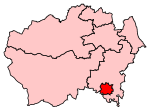Longfield Academy, Darlington
Academies in the Borough of DarlingtonCounty Durham building and structure stubsNorth East England school stubsSchools in DarlingtonSecondary schools in the Borough of Darlington ... and 1 more
Use British English from February 2023
Longfield Academy (formerly Longfield Comprehensive School, Longfield Academy of Sport) is a coeducational secondary school located in Darlington, County Durham, England.Previously a community school administered by Darlington Borough Council, Longfield School converted to academy status in August 2011 and was renamed Longfield Academy. However, the school continues to coordinate with Darlington Borough Council for admissions.Longfield Academy offers GCSEs and BTECs as programmes of study for pupils. Due to once being a sports academy, the school has built up sports facilities, and hires out these facilities for use by the local community.
Excerpt from the Wikipedia article Longfield Academy, Darlington (License: CC BY-SA 3.0, Authors).Longfield Academy, Darlington
Longfield Road,
Geographical coordinates (GPS) Address Website External links Nearby Places Show on map
Geographical coordinates (GPS)
| Latitude | Longitude |
|---|---|
| N 54.54827 ° | E -1.55422 ° |
Address
Longfield Academy
Longfield Road
DL3 0HT , Harrowgate Hill
England, United Kingdom
Open on Google Maps








